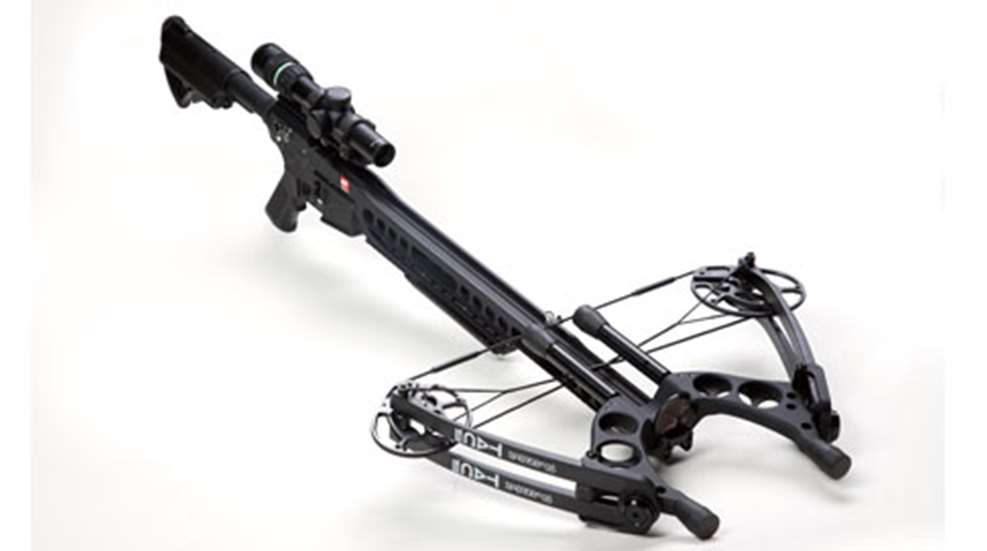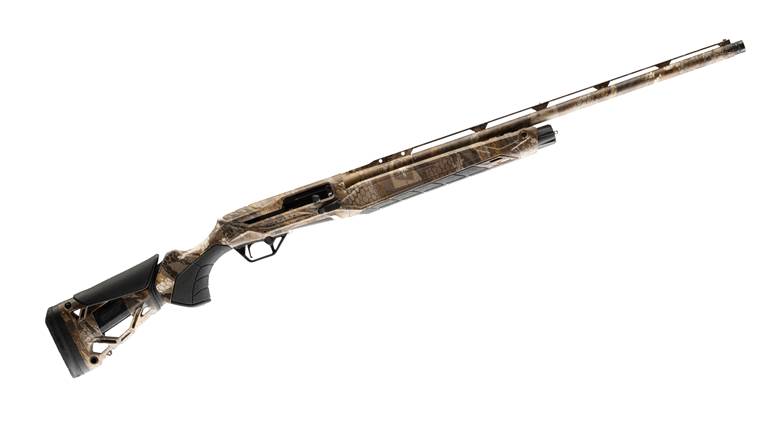
With its Tactical Assault Crossbow 15 (TAC 15) and TAC 10, Precision Shooting Equipment (PSE) of Tucson, Ariz., has taken the initiative to bridge the gap between firearms and archery equipment in a most unusual and innovative way, and thus lend further credibility to the one-gun-for-all-hunting concept.
Essentially an AR-15 upper receiver, the TAC 15 consists of the CNC-machined aluminum front assembly, or bow, secured via two 5/16-24 screws to the like-machined aluminum barrel assembly. When attached to an AR-15 lower receiver assembly, the fire controls of which are used in its operation, the package serves as a complete crossbow. Traits of the TAC 15’s trigger, such as pull weight, creep and overtravel, reflect the performance of the unit in the chosen AR-15 low receiver. That said, most factory-installed AR-15 triggers offer an improvement over what is found on the typical crossbow; however, there are numerous aftermarket AR-15 triggers available if replacement is desired. PSE reports the TAC 15 has a quick, 12-millisecond lock time.
The barrel assembly, which measures 28 inches in length and 34 inches when combined with the front assembly, and is instrumental in achieving the unit’s 17¼- inch power stroke, is skeletonized to reduce weight. The barrel and front assemblies together weigh 6 pounds, 10.2 ounces When a lower receiver, such as the Smith & Wesson M&P15 Viking Tactics used for testing, is added, the weight increases—8 pounds, 11.6 ounces in this case. With the buttstock fully extended, the TAC 15’s length was 44 5⁄8 inches—both exceed most other crossbows on the market.
Unlike most crossbow designs, in which a barrel channel serves as the bolt’s guide, the TAC 15’s barrel directs only the sled-like cocking mechanism; a Whisker Biscuit rest on the front assembly captures and guides the PSE TAC 15 arrow—the TAC 15 can use only the 2613⁄16-inch-long arrows (not bolts) available from PSE. This departure from the norm enables the TAC 15, like a compound bow, to be fine-tuned for optimal arrow flight, and thus better accuracy. And when combined with its arrow’s pronounced nocking point—as opposed to the flat or half-moon face of a typical bolt simply at rest against the string as found on other crossbow models—accuracy is further improved. In addition to a 7¼-inch section of Picatinny rail for mounting optics (the TAC 15 is devoid of sights), the front, lower portion of the barrel assembly and free-floating fore-grip have sections of rail for adding accessories. A 61⁄8-inch-long textured polymer section is factory-installed on the fore-grip for enhanced purchase and comfort.
The front assembly, which features a split-limb design incorporating PSE’s short, yet high-performance X-Tech limbs and TAC cams, measures 17 inches axle-to-axle (traditional method of measuring crossbow width) at rest, and 12 inches when drawn. Actual tip to tip—an important consideration in tight quarters, such as a small ground blind—width is 20 7⁄8 inches.
Immediately noticeable is the lack of a foot stirrup for cocking; instead, the TAC 15 uses a cocking aid built into the barrel assembly. To prevent an accidental dry-fire, the unit features an anti-dry-fire catch; however, attention should still be paid to whether or not an arrow is nocked.
To load, the user pushes down on the ratchet release lever (on the left rear of the receiver), which frees the release assembly (sled-like mechanism) to be pulled toward the string. The string loop can then be placed on the release hook and the arrow nocked. Then, with the crossbow pointing in a safe direction, using the supplied crank, which attaches to the 1/4-inch square drive on the right rear of the receiver, the string can be cranked—with minimal effort, even with a 155-pound peak weight—back to full draw. The crossbow is ready to shoot; however, the safety should be placed on “safe” until ready to fire. (The safety can be placed on “safe” prior to cocking only after joining the TAC 15 to the lower. During subsequent firings, the safety cannot be manipulated until the crossbow is fully cocked.) The TAC 15’s design enables the bow to be easily let down without firing, which is among its greatest features.
According to factory-published numbers, using a 425-grain PSE TAC 15 arrow, the TAC 15 attains 392-402 fps, for 145-153 ft.-lbs. of kinetic energy. An Easton chronograph revealed the test unit’s average with 427-grain arrows as 402 fps for five consecutive shots at 3 feet—right in line with the company’s published numbers, even considering the arrows’ slightly heavier average weight.
To evaluate the TAC 15 for accuracy, it was topped with a Trijicon 1-4X 24 mm riflescope (which withstood the unique vibrations of the crossbow) in the company’s rings and fired from a Caldwell Lead Sled to reduce human error. At 40 yards, the TAC 15 averaged an incredible 1.69 inches for three consecutive, three-shot groups—even with one 2.78-inch group in the average. It is also worthy of note that, to the evaluator, an avid crossbow and compound bow hunter, the TAC 15 was very quiet when shooting; however, the same could not be said for cocking. Fortunately, if one were to remove the arrow, such as would be procedure for crossing a fence or pulling up the TAC 15 to a tree stand on a rope, the TAC-15’s design enables arrow re-nocking without having to let the bow down and re-cock, thereby eliminating noise.
The TAC 15 does not come with a quiver. However, side, back and backpack models that are suitable for arrows for traditional and compound bows will also work with the TAC 15 arrows.
At $1,300, the TAC 15 is a substantial expenditure; however, considering the price of many crossbow models, it’s not entirely out of the question, either. AR-15 aficionados who want the most from their favorite platform, as well as those who want to extend their hunting season or take up an alternative hunting method, should consider the TAC 15. It certainly lends credibility to the “gun-for-all-seasons” concept.
Manufacturer: PSE, Inc.; (520) 884-9065; www.pse-archery.com
Draw Weight: 155 lbs.
Advertised Speed: 393-402 fps (425-gr. arrow)
Tested Speed: 402 fps
Advertised Kinetic Energy: 145-153 ft.-lbs.
Axel-to-Axel Length: 17"
Power Stroke: 17¼"
Overall Length (With Full-Length Stock): 445⁄8"
Trigger Pull Weight: depends on AR-15 lower receiver
Weight: 6 lbs., 10.2 ozs. (upper only); 8 lbs., 11.6 ozs. (upper and lower)
Accessories: three arrows, cranking device, dvd, owner’s manual
Suggested Retail Price: $1,299 (TAC 15 upper only)





































